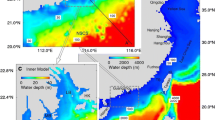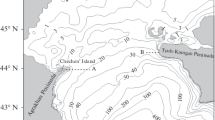Abstract
The mechanism governing the mean state and the seasonal variation of the transports through the straits of the Japan Sea is studied using a newly presented, simple analytical model and a basin scale general circulation model (GCM). The GCM reproduces the transports through the straits of the Japan Sea realistically owing to its fine horizontal resolution of about 20 km and realistic topography. A series of experiments conducted by changing surface forcing shows that the annual mean wind-driven circulation in the North Pacific Ocean is most responsible for the formation of the mean transports. It is also found that the seasonal variation of the alongshore component of monsoonal wind stress over the North Pacific basin, especially that over the Okhotsk Sea, is responsible for the seasonal variation of the transports. The simple analytical model can explain these simulated features very well. The physical concept of this model is based on the formation of the around-island circulation through the adjustment of coastally trapped waves and Rossby waves and geostrophic control at the narrow straits. It solves the sea surface heights (SSHs) at the edge of each strait and the transport through it. The value of the line integral of the SSH along the island is determined by the baroclinic Rossby waves approaching the island from the east and the alongshore wind stress around the island. The basin scale seasonal variation of SSH along the coast induced by the variation of the alongshore monsoonal wind stress can also be incorporated into this model by giving the SSH anomaly at the northeastern point of the Soya Strait. Thus, it is suggested that both the mean state and the seasonal variation are caused mainly by wind stress forcing. Minor modification by the seasonal heat flux forcing brings the amplitude and the phase of the seasonal variation closer to the observed values.
Similar content being viewed by others
References
Csanady, G. T. (1978): The arrested topographic wave. J. Phys. Oceanogr., 8, 47–62.
Durland, T. S. and B. Qiu (2003): Transmission of subinertial Kelvin waves through a strait. J. Phys. Oceanogr., 33, 1337–1350.
Ebuchi, N. (2006): Seasonal and interannual variations in the East Sakhalin Current revealed by TOPEX/POSEIDON altimeter data. J. Oceanogr., 62, 171–183.
Godfrey, J. S. (1989): A Sverdrup model of the depth-integrated flow from the world ocean allowing for island circulations. Geophys. Astrophys. Fluid. Dyn., 45, 89–112.
Griffies, S. M. and R. W. Hallberg (2000): Biharmonic friction with a Smagorinsky-like viscosity for use in large-scale eddy-permitting ocean models. Mon. Wea. Rev., 128, 2935–2946.
Hirose, N. and K. Fukudome (2006): Monitoring the Tsushima Warm Current improves seasonal prediction of the regional snowfall. SOLA, 2, 61–63, doi:10.2151/sola.2006-016.
Holland, W. R., J. C. Chow and F. O. Bryan (1998): Application of a third-order upwind scheme in the NCAR ocean model. J. Climate, 11, 1487–1493.
Igeta, Y., Y. Kitade and M. Matsuyama (2005): Numerical experiments on scattering of coastal-trapped waves by topography and bays. Umi no Kenkyu, 14, 441–458 (in Japanese with English abstract).
Ishikawa, I., H. Tsujino, M. Hirabara, H. Nakano, T. Yasuda and H. Ishizaki (2005): Meteorological Research Institute Community Ocean Model (MRI.COM) Manual. Technical Reports of the Meteorological Research Institute, No. 47 (in Japanese).
Ishizaki, H. and T. Motoi (1999): Reevaluation of the Takano-Oonishi schemes for momentum advection on bottom relief in ocean models. J. Atmos. Oceanic. Technol., 16, 1994–2010.
Itoh, M. and K. I. Ohshima (2000): Seasonal variations of water masses and sea level in the southwestern part of the Okhotsk Sea. J. Oceanogr., 56, 643–654.
Johnson, H. L. and C. Garrett (2006): What fraction of a Kelvin wave incident on a narrow strait is transmitted? J. Phys. Oceanogr., 36, 945–954.
Kajiura, K. (1974): Effect of stratification on long period trapped waves on the shelf. J. Oceanogr. Soc. Japan, 30, 271–281.
Kalnay, E. and Co-authors (1996): The NCEP/NCAR 40-year reanalysis project. Bull. Amer. Meteor. Soc., 77, 437–471.
Killworth, P. D. (1989): Transition of a two-Layer coastal Kelvin waves over a ridge. J. Phys. Oceanogr., 19, 1131–1148.
Kondo, J. (1975): Air-sea bulk transfer coefficients in diabatic conditions. Boundary-Layer Meteorology, 9, 91–112.
Levitus, S. and T. P. Boyer (1994): World Ocean Atlas 1994, Vol. 4, Temperature. NOAA Atlas NESDIS 4, 111 pp.
Levitus, S., R. Burgett and T. P. Boyer (1994): World Ocean Atlas 1994, Vol. 3, Salinity. NOAA Atlas NESDIS 3, 99 pp.
Liu, Z., L. Wu and H. Hurlburt (1999): Rossby wave-coastal Kelvin wave interaction in the extratropics. Part II: Formation of island circulation. J. Phys. Oceanogr., 29, 2405–2418.
Lyu, S. J. and K. Kim (2005): Subinertial to interannual transport variations in the Korea Strait and their possible mechanisms. J. Geophys. Res., 110, C12016, doi:10.1029/2004JC002651.
Matsuyama, M., M. Aota, I. Ogasawara and S. Matsuyama (1999): Seasonal variation of Soya Current. Umi no Kenkyu, 8, 333–338 (in Japanese with English abstract).
Minato, S. and R. Kimura (1980): Volume transport of the western boundary current penetrating into a marginal sea. J. Oceanogr. Soc. Japan, 36, 185–195.
Mizuta, G., K. I. Ohshima, Y. Fukamachi and M. Wakatsuchi (2005): The variability of the East Sakhalin Current induced by winds over the continental shelf and slope. J. Mar. Res., 63, 1017–1039.
Mysak, L. A. (1980): Recent advances in shelf wave dynamics. Rev. Geophys. Space Phys., 16, 233–261.
Nof, D. (2000): Why much of the Atlantic circulation enters the Caribbean Sea and very little of the Pacific circulation enters the Sea of Japan. Prog. Oceanogr., 45, 39–67.
Noh, Y. and H.-J. Kim (1999): Simulations of temperature and turbulence structure of the oceanic boudary layer with the improved near-surface processes. J. Geophys. Res., 104, 15,621–15,634.
Ohshima, K. I. (1994): The flow system in the Japan Sea caused by a sea level difference through shallow straits. J. Geophys. Res., 99, 9925–9940.
Pedlosky, J. (1996): Ocean Circulation Theory. Springer, Berlin Heidelberg, 453 pp.
Sato, Y., S. Yukimoto, H. Tsujino, H. Ishizaki and A. Noda (2006): Response of North Pacific ocean circulation in a Kuroshio-resolving ocean model to an Arctic Oscillation (AO)-like change in Northern Hemisphere atmospheric circulation due to greenhouse-gas forcing. J. Meteor. Soc. Japan, 84, 295–309.
Seung, Y. H. (2003): Significance of shallow bottom friction in the dynamics of the Tsushima Current. J. Oceanogr., 59, 113–118.
Shikama, N. (1994): Current measurement in the Tsugaru Strait using bottom-mounted ADCPs. Kaiyo Monthly, 26, 815–818 (in Japanese).
Simizu, D. and K. I. Ohshima (2006): A model simulation on the circulation in the Sea of Okhotsk and the East Sakhalin Current. J. Geophys. Res., 111, C05016, doi:10.1029/2005JC002980.
Smith, W. H. F. and D. T. Sandwell (1997): Global sea floor topography from satellite altimetry and ship depth soundings. Science, 277, 1956–1962.
Takikawa, T., J.-H. Yoon and K.-D. Cho (2005): The Tsushima warm current through Tsushima Straits estimated from ferryboat ADCP Data. J. Phys. Oceanogr., 35, 1154–1168.
Toulany, B. and C. Garrett (1984): Geostrophic control of fluctuating barotropic flow through straits. J. Phys. Oceanogr., 14, 649–655.
Tsujino, H., N. Usui and H. Nakano (2006): Dynamics of Kuroshio path variations in a high-resolution general circulation model. J. Geophys. Res., 111, C11001, doi:10.1029/2005JC003118.
Wajsowicz, R. C. (1993): The circulation of the depth-integrated flow around an island with application to the Indonesian Throughflow. J. Phys. Oceanogr., 23, 1470–1484.
Wajsowicz, R. C. (1996): Flow of a western boundary current through multiple straits: An electrical circuit analogy for the Indonesian throughflow and archipelago. J. Geophys. Res., 101, 12,295–12,300.
Wajsowicz, R. C. (2002): A modified Sverdrup model of the Atlantic and Caribbean circulation. J. Phys. Oceanogr., 32, 973–993.
Weatherly, G. L. (1972): A study of the bottom boundary layer of the Florida Current. J. Phys. Oceanogr., 2, 54–72.
Author information
Authors and Affiliations
Corresponding author
Rights and permissions
About this article
Cite this article
Tsujino, H., Nakano, H. & Motoi, T. Mechanism of currents through the straits of the Japan Sea: Mean state and seasonal variation. J Oceanogr 64, 141–161 (2008). https://doi.org/10.1007/s10872-008-0011-7
Received:
Revised:
Accepted:
Issue Date:
DOI: https://doi.org/10.1007/s10872-008-0011-7




